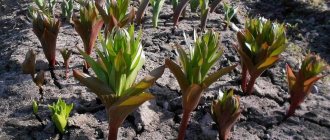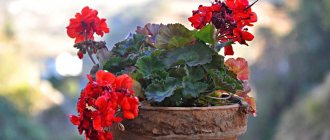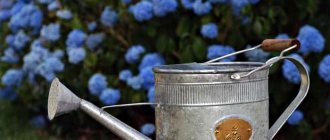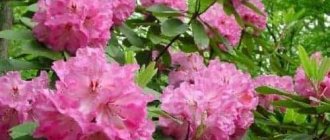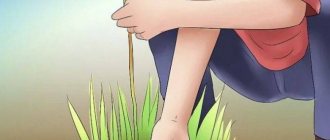Ampelous petunia is a bright and lush flowering plant, which is often used to decorate balconies and verandas, as well as vertical gardening in landscape design. Abundant and long flowering has made it a particularly popular choice of most domestic and foreign gardeners.
Petunias in hanging pots (plant pots) serve as a traditional decoration for urban and country landscapes and home interiors.
Basic rules for caring for ampelous petunia
Ampelous petunia is an unpretentious plant that pleases with abundant flowering. There are several varieties of the flower: Supertunia, Surfinia, Tumbelina and Fortunia. Growing a beauty is not difficult if you follow the rules of planting and care.
Landing
The crop is grown mainly in hanging pots and garden boxes. Before transplanting petunia to a permanent place, seedlings are grown, which are obtained by seed or cuttings.
Petunia seeds are tiny, so sowing them is a challenge for patient gardeners. The success of cultivation depends on the quality of the seed material and subsequent care. It is important to maintain optimal humidity and temperature in the room. For favorable flower growth, the air temperature should be +23…+24°C. At low values, seedling growth will stop; at high values, the seedlings will dry out. Sowing is done in February.
The procedure for planting seeds is divided into several stages:
- The seedling substrate is generously watered with a light pink solution of potassium permanganate. Peat tablets or ready-made soil mixture from a garden store are suitable for planting.
- Seedling boxes are filled with moist soil and seeds are sown on the surface. 0.5 mm of soil is poured on top and the container is covered with film or glass. The boxes are placed on a shaded windowsill and left in this form for 10–14 days. There is no need to remove the cover, and when watering the soil there will be enough moisture for future seedlings.
- After the first shoots appear, the cover is removed, and when watering, the seedlings are fed with potassium fertilizers. Water is poured through a strainer or sprayer. The time for airing seedlings is gradually increased by 5–10 minutes. Remove the cover completely after the first leaves appear.
A strong and healthy mother bush with a large number of buds is suitable for cuttings. The procedure is carried out at the end of winter, when the plant is dormant. At the end of August, all long shoots are cut off, and the pot with the bush is sent to the basement or other room with an air temperature no higher than +4°C. The plant is illuminated with a phytolamp, creating an artificial daylight hours of 12–16 hours. In January the bush will begin to wither, this is normal. In the spring it will send out young shoots again.
At the end of February - beginning of March, they begin cutting cuttings 10–12 cm long. The two upper leaves are cut in half, the lower ones are completely removed. The cuttings are planted in the prepared substrate immediately after cutting. The soil should be loose and nutritious. The cuttings are buried 4-5 cm every 2-3 cm. The boxes are covered with film or a glass jar.
Some people build an improvised greenhouse: they bend a thick wire in an arc and stretch a film on top. The container is placed on a shaded windowsill, maintaining daylight for at least 10 hours. The cover is periodically removed and the cuttings are sprayed with warm, settled water. Water is poured into a tray to prevent the development of blackleg: the disease usually manifests itself when watered abundantly directly into the ground.
After the first leaves appear, the cuttings are planted in a pot in a permanent place. If you plan to grow petunia in open ground, transplantation is postponed until May. The culture does not like frequent replanting and responds with stunted growth and weak flowering. Therefore, it is advisable to decide on the place of cultivation in advance.
To plant petunias in a permanent place, use a ready-made soil mixture; the main thing is that it is of high quality and has a loose structure. To prepare it yourself, flower growers take 2 parts of turf, 1 part each of peat and river sand, and mix in a few handfuls of perlite. The components are mixed in a large container, poured over with a pink solution of potassium permanganate, and 20–30 g of superphosphate are added per 10 liters. Loose soil perfectly allows moisture to pass through, which does not linger in the root area.
Advice! Instead of regular peat, use coconut substrate. Its fibrous structure perfectly loosens heavy soil and provides the plant with nutritional components.
Petunia is often grown in ceramic, plastic pots or wooden boxes. The material of the container does not play a special role; It is important that there are holes at the bottom to drain excess water. Expanded clay or a sponge is placed at the bottom of the container to absorb moisture. The prepared soil mixture is poured on top and a depression is made. The seedlings are carefully removed from the pots and planted together with a ball of earth at the growth level, without being buried or raised too high.
If you place the pot in bright sun, the soil will constantly become covered with dry crust and cracks. In this case, the containers are only half filled with soil, and peat or coconut substrate is poured from above to the brim. Petunia grows quickly and is able to independently protect the roots from drying out, but at the initial stage this planting principle will help retain moisture inside the soil.
Ampelous petunia has a developed root system that requires sufficient space for growth. The optimal container volume for one bush is 5 liters. In a pot that is too small, the petunia will be pale and emaciated, with thin shoots and small buds. Several bushes can be planted in one pot, provided that there is enough space for their growth and development. In some types of ampelous petunia, the root system takes up little space, so the plants get along well in the neighborhood. The most friendly varieties are alyssum and lobelia.
Features of care
Caring for ampelous petunia is simple, regardless of the variety. The plant loves sunlight, abundant watering and spraying, especially in the heat. When watering and spraying water, it is important not to get it on the buds and flowers. In dry weather, the bushes are moistened in the morning and evening. The root ball should be completely wet so that the water comes out through the drainage holes.
Petunia in hanging pots with peat or coconut substrate is soaked in a large basin of water once a week. It is important to ensure that the substrate is completely wet.
For ampelous petunia, the golden mean is important - the soil mixture should not be too wet or dry. Repeated watering is carried out after the soil has dried out by 2-3 cm. If you rub a lump of soil from the top layer between your fingers and it turns out to be dry, then you can water.
Advice! To reduce the frequency of watering, gardeners add hydrogel to the soil, which perfectly retains moisture and, if necessary, releases it to the roots. This technique reduces the frequency of moistening petunia by 2-3 times.
Dried flowers, leaves, seed pods, long shoots are removed 1-2 times a week. Some varieties of ampelous petunia grow chaotically, with shoots directed in different directions. To maintain a neat shape and lush flowering, the bushes are cut with sharp pruning shears. The procedure does not harm the plant at all, but maintains its beauty and health.
Complex fertilizers are applied once a week. The composition should be dominated by potassium and phosphorus. It is recommended to feed petunias from the Potunia group with each watering, reducing the concentration of the solution to 2-3 g/l. Without this, it will not be possible to get a beautifully designed, lushly blooming cascade.
For feeding, use any complex liquid fertilizer for flowering plants. The concentration should not exceed 5 g per 10 liters of water.
Do not apply fertilizers on dry soil, as there is a risk of burns on the roots. It is recommended to combine watering and fertilizing or follow this principle: water in the morning, fertilize in the evening.
Features of seed selection and planting dates
When it comes to a flower like petunia, caring for and growing it at home is not much of a mystery. The procedure, although somewhat complicated, is interesting for flower growers. And its solution begins with studying the planting dates.
The time for sowing seeds in different regions does not coincide. Therefore, when choosing seed material, this important aspect is taken into account.
Choosing the right seeds is important
Approximate planting times by region:
- Siberia, Ural, Leningrad region - second half of March - first half of April;
- Krasnodar region - early February;
- The middle zone is mid-February.
No planting will be carried out at earlier dates. Due to overexposure, the sprouts stretch out, do not tolerate picking well, and more often get sick and die.
January and February are favorable for sowing ampelous and cascading petunias. Seeds of these varieties need more time to sprout and form shoots.
Many gardeners take into account the indications of the lunar calendar. The sowing schedule will help you figure out which days to choose for sowing, picking and other activities.
Choice
Seed propagation of petunia will be more successful with the correct choice of planting material. First, the type of plant desired is determined. Choose bush, ampelous or cascading petunia. Then the color of individual specimens is selected in accordance with the color scheme of the balcony, garden, gazebo.
Appearance of seeds
Among seed producers, the most popular groups are “Gavrish”, “Search”, “Aelita”. They sell quality seeds, but often gardeners use seeds they collect themselves.
The size of petunia seeds is 0.2–0.5 mm, which creates difficulties during sowing. Therefore, it is better to choose granules or dragees, wrapped in a nutritious shell, which contains disinfectants and growth-accelerating drugs. The package contains step-by-step instructions for sowing seeds.
Pinching ampelous petunia
Pinching ampelous petunia is a mandatory procedure. The first time it is carried out when the central shoot reaches 15–20 cm in height. If you do this earlier, the side shoots will become very elongated, and the central part will stop growing.
Faded buds along with seed pods are picked off once a week. This is included in the list of mandatory procedures, otherwise the flower will enter the fruiting phase and devote all its energy to ripening the seeds. New buds will not form and the plant will lose its decorative appearance.
After heavy rain and during cold weather, the roots of the plant begin to rot, and the shoots begin to grow. Therefore, it is important to pinch out all elongated stems and deformed buds.
Reference. For a hanging variety, it is useful when the bushes spread out wide and many young shoots form on them. This increases the number of flowers and improves decorativeness.
Rules for pinching petunias:
- use of sterile instruments - scissors, pruners;
- careful removal of weak shoots, without sudden movements;
- cutting off all rotten and dry stems, flowers, leaves.
After pruning, the plant is fed with mineral supplements (“Flower Garden”, “Agricola”) and growth stimulants (“Kornevin”, “Epin”, “Zircon”).
How to pinch to make petunia lush
The tops of flowering bushes of ampelous petunia are formed by pruning the side shoots. Bushes that have already been pinched at the seedling stage are planted in a permanent place, and therefore actively produce young shoots. Flower growers are creative in this procedure, giving the plant any shape. The shoots are left long, cascading like a colorful waterfall or in the form of a neat cap. Regular pinching of flowering petunia and removal of weak stems promote lush flowering.
Pinching seedlings
The first pinching of seedlings is carried out 70–75 days after sowing the seeds. The seedlings should have 5-6 true leaves. The procedure is performed with nail scissors or a sharp knife. It is not advisable to pinch petunia by hand, as evidenced by reviews from many gardeners. This increases the risk of damage to tender shoots and infection.
Repeated pinching for lush flowering, maintaining active branching of shoots, and increasing the number of buds is carried out after 30 days. Too frequent a procedure leads to weakening of the plant and stunted growth.
Removing cover
Petunia is very sensitive to air humidity. At first, the seedlings are kept under a glass or film cover. It is convenient to grow seedlings in plastic containers with a transparent lid. The shelter is removed briefly every day to ventilate the mini-greenhouse. If this is not done, mold may appear on the surface of the soil.
It is impossible to remove the cover completely at once. Due to a sharp decrease in air humidity, seedlings may die. You need to accustom petunia to the open air gradually, spreading the process over several days. Every day the shelter is moved slightly, increasing the gap. After 4-5 days, the glass or film is completely removed.
How to form an ampelous petunia
Sometimes, even with careful care of ampelous petunia, the shoots grow - the lower part becomes bare, and new buds and leaves appear only on the tops . In such cases, it is recommended to perform emergency pinching. Flower growers remove 2/3 of the shoot, leaving the bush almost bald. If you remove only the top, new buds will appear at the ends of the shoots, but the bare part will remain that way.
Molding is done in two steps so as not to completely expose the entire pot. First, 2 shoots are cut off, after 7 days - 2 more, and finally the remaining stems are cut off. With this forming, flowering shoots will constantly be present on the bush and new ones will gradually appear.
When molding slowly, it is not pinching that is performed, but trimming. Between the branches leave 2-3 internodes from the ground. New shoots grow from them, and after 10–14 days the plant begins to bush and bloom luxuriantly.
What to do if it grows upward
Ampelous petunia begins to grow upward and become very elongated at the seedling stage due to a lack of light. On cloudy days, plants are illuminated with phytolamps around the clock. At night, the light is dimmed. The lamps are installed at a distance of 25 cm from the flower. The air temperature should be +25°C.
Attention! For mature seedlings, such lighting and temperature are detrimental: the shoots begin to stretch out greatly and soon die. To solve the problem, flower pots are moved to a cooler place.
It is recommended to thin out dense bushes or completely remove weak plants. It is advisable to plant dense seedlings into separate containers and create a temperature regime within +18°C.
Suitable temperature
Seeds should germinate at room temperature. After the emergence of seedlings, the temperature regime is changed. Excess heat, especially in combination with a lack of light, causes seedlings to stretch out.
In such conditions, the seedlings will be frail and thin. Immediately after the sprouts appear from the ground, it is necessary to reduce the temperature to +17-21 °C. It is also advisable to ensure a difference between day and night temperatures of 3-4 degrees.
How to prune a plant
To prune petunia without losing quality, it is important to know how to do it correctly. For the procedure, use pruning shears (garden shears) or a sharp knife. Instruments are disinfected with a strong solution of potassium permanganate or medical alcohol.
In order for the plant to recover faster, the procedure is carried out in compliance with a number of rules:
- on each stem, remove the top 3-4 cm long;
- pruning is performed in the morning or evening;
- The cuttings are placed in a container with water so that they do not dry out.
In order for the ampelous petunia to bloom in a lush cascade, the flowing thin stems are cut to ½ length. The procedure is carried out in July, when the flower no longer has time to grow long lashes. Ampelous varieties are pruned when they begin to lose their decorative properties.
Pruning is performed 2-3 days before fertilizing in order to provide the plant with additional nutrition and activate lush flowering.
Cuttings after pruning are used for further propagation. They are able to take root on their own. If you place them in the Kornevin solution, the process will go faster.
Flower propagation
Ampelous petunia is propagated by seed and cuttings. The first method is considered the most labor-intensive due to the microscopic size of the seed material. Some gardeners practice sowing on a layer of snow, which, as it melts, carries the seeds with it. Picking is carried out after the appearance of 5-6 leaves.
The green cutting method is used mainly when growing ampelous petunia. To cut green cuttings, take ripened shoots. The length of the cutting is 5-6 cm. It is most convenient to root them in peat tablets. The process takes 1-2 months. With "Gumat" or "Epin" rooting is faster.
The best varieties
The homeland of petunia is South America, from where it was brought to Europe in the 18th century and immediately captivated flower growers. Since that time, breeding work has begun to develop new varieties of the plant, of which hundreds are now known.
Catherine
Petunia with large flowers with a diameter of about 6 cm. The main color is orange, with red and yellow tints.
Ekaterina F1
The Snow Queen
This pendula fully lives up to its name - its petals are painted snow-white. The length of the shoots is average.
The Snow Queen has an unobtrusive, pleasant aroma with subtle notes.
Snow Queen F1
Black velvet
This is a unique variety of ampelous petunia with black petals. The diameter of the flower is about 8 mm. The bush is highly branched, the length of the shoots is from 25 to 35 cm.
Black velvet
Protection from diseases and pests
Ampelous petunias are distinguished by enviable health and are attacked by insects only in unfavorable conditions. The main flower pests are aphids, spider mites, and thrips. The fight against them begins in the early stages.
The first sign of a spider mite is the thinnest cobwebs on the leaves. Thrips settle on bushes during the flowering period, damaging leaves and anthers. Aphids quickly spread throughout the plant. When examining the back side of the leaves, you can see whole hordes of black or green bugs that feed on plant juices.
To kill insects, systemic insecticides “Teppeki”, “Aktara”, “Konfidor” are used. Processing is carried out strictly according to the instructions.
Preparing seedlings
The seedlings should be in a well-lit room at an air temperature not exceeding 20 degrees. In cloudy weather, it is recommended to turn on the lamp. Neglecting these factors will lead to excessive elongation and bending of the stems.
The soil for seedlings should be nutritious, porous and low in acidity. It is recommended to purchase the soil mixture in stores - such soil is previously cleared of clay, weeds, and insects. Petunias love soil with the addition of humus, peat or wood ash.
Advice from experienced flower growers
In order for ampelous petunia to delight with abundant flowering all season long, experienced flower growers recommend following a number of rules:
Easy Wave
- In many varieties of ampelous petunias, growth is determined genetically: the central stem stops developing, only lateral shoots grow. The most famous varieties and hybrids: Easy Wave, Tidal Wave, Rose Wayne Velvet, Opera. There are plants that require pinching of the central shoot to ensure lush branching and flowering. The sooner the pinching is done, the better the result.
- To rejuvenate the bushes, it is important to regularly remove dry and faded flowers and trim old branches short.
- The young bush is molded when 2-3 pairs of true leaves appear on it. First of all, cut off the central shoot, then the side shoots. If you pinch frequently, the bush will be more luxuriant.
- A month after pinching and the appearance of side shoots, pinching the tops is repeated.
- To plant large buds and brighten the flowers, the bushes are watered with complex fertilizers.

